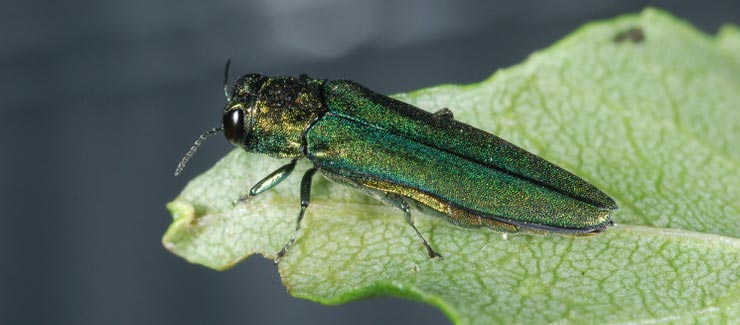Now that the emerald ash borer has arrived in Maine – it is well established in York County, spreading in northern Aroostook County and was found in Portland for the first time last October – is there anything you can do anything to save your trees from the highly destructive invasive beetle?
The state is carefully tracking the continuing spread of the pest, in part by setting out pheromone and other traps to determine its reach, Alison Kanoti, state entomologist with the Maine Forest Service, said in a telephone interview. The Maine Forest Service is taking steps to slow its spread and is offering advice to property owners so they can protect their own trees. At the same time, the city of Portland is developing a plan.
Ever since it arrived in Michigan in 2002, the pest has decimated ash trees in a vast region of the United States. The adult insects eat the leaves of the trees. Their larvae are more destructive, eating the tissue underneath the bark, which disrupts the tree’s ability to get nutrients and water from the roots to the leaves, eventually killing the tree.
Three species of ash, all susceptible to the pest, are native to Maine: white ash (Fraxinus Americana), the most abundant; black ash (Fraxinus nigra), sometimes called brown ash, which is historically important to Wabanaki tribes for basket making and more; and green ash, Fraxinus pennsylvanica, which, while common, is less abundant than the others; it frequently grows along rivers.
Additionally, in the 1970s and ’80s state and local officials, as well as homeowners, planted ash trees throughout Maine in parks and yards and along streets. By a curious twist of fate, many of these ash trees were planted to replace the elms that had only recently been decimated by Dutch elm disease.
One course of action is pesticides. Several pesticides are effective in saving ash trees, Kanoti said. For the most part, the pesticides are either injected into the tree or put into the ground at its base, usually by professional arborists.
Timing is crucial. “We do not recommend treatment unless emerald ash borer has been confirmed within about 10 miles of the trees of concern,” she said. Applying such pesticides before the pest is within that radius wastes money. More importantly, it adds poisons to the environment unnecessarily.
Before attempting to save their ash trees, though, homeowners will need to decide which ones to save. And they should make that decision before the trees are infected, Kanoti said. While chemical treatment (in other words, pesticides) can work in early stages of infection, it does not work as well, if at all, once a tree is severely damaged.
“They should consider the role the tree plays in the landscape,” Portland City Arborist Jeff Tarling said. “Is it a specimen tree in the front lawn giving shade, or is it a grove of small ash trees growing in the side or back of the property?”
He suggests people reserve treatment for large trees in prominent locations, about 12 inches in diameter at an adult’s breast height (about 4 1/2 feet from the ground).
Another way to repel, or at least slow, the emerald ash borer is by tree girdling. You pick a tree you are willing to sacrifice and remove a strip of bark from the entire circumference of its trunk. Doing so eventually will kill the tree. The beetles are especially attracted to sick trees, so they will attack that tree, rather than nearby healthy ones.
The state also has released a biocontrol, Kanoti said, in the form of tiny wasps that can kill the emerald ash borer but do not sting people.
It’s important to treat, or remove, a tree early. Once it’s badly infected, it’s unsafe to work on, as the emerald ash borer destroys the tree’s structural integrity. At that point, just let the bugs finish eating the tree.

This ash tree was killed by the emerald ash borer, which has swept a destructive path across the United States and is now in Maine. Shutterstock
One of the most important stretches of ash in Maine follows Interstate 95, just inland from the coast, Kanoti said. The state is making a special effort to protect that area. As for Portland, the city has about 600 ash trees along its streets and on public grounds, Tarling said, and is working with the Forest Service on a strategy to save some of them. Saving all of them, given the resources available – financial and otherwise – is not realistic. Not all of Portland’s trees were planted; some grew naturally. “Along some of the riparian areas or riverbanks along the Presumpscot River, we have stands of ash trees that are important floodplain trees providing habitat, cooling the river, protecting the riverbank from erosion,” Tarling said.
Finally, Kanoti also had a recommendation for foresters: While it makes sense for foresters to harvest more ash trees than ordinarily before the beetle hits hard, she said they shouldn’t cut down all of them. “Consider leaving ash that are too small to be harvested for sawlogs, especially those of good form and health,” she said. “There is evidence that a portion of ash, especially white ash, is resistant and/or tolerant to EAB.”
With luck, the resistant trees will be left standing, surviving both the foresters’ chainsaw and the beetles’ appetite and pointing a way toward an enduring future for ash trees in Maine.
And that would be good news.
Tom Atwell is a freelance writer gardening in Cape Elizabeth. He can be contacted at: tomatwell@me.com.
Send questions/comments to the editors.



Comments are no longer available on this story